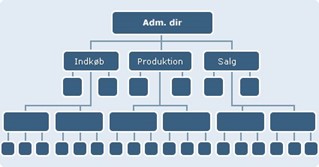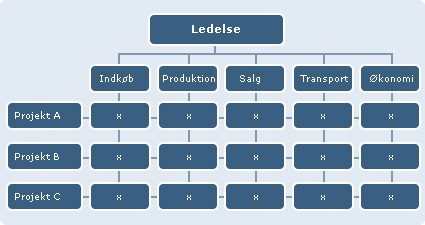E4: Organization of the company
Organization of the Company
Flat organizational structure:

The flat organizational structure is characterized by few or in the extreme case no middle management, so that employees report directly to the top management.
The idea behind the flat structure is that employees will be more productive and engaged when participating in decision-making processes. At the same time, comments, and feedback in connection with decisions will reach the employees faster than in a hierarchical organizational structure. The structure can be more time consuming than the hierarchical one, as decision making processes involve several people.
Only small companies will be able to achieve a completely flat structure, and companies of a cartain size will therefore be forced to introduce one or more levels of management between the employees and the top management.
Advantages of a flat organizational structure:
- Higher motivation among employees due to the opportunity to influence their own work situation.
- Greater flexibility and faster responsiveness and decision-making process
- Relieves the management, which is given the opportunity to concentrate to a greater extent on key tasks.
Disadvantages of a flat organizational structure:
- Resource demanding
- Reduces the overview of the organization
- It is difficult to balance different functional groups against each other, as decisions about strategy, resource allocation, etc. in the groups are not made centrally
- Risk of “bottleneck” problems in the organization if everyone must spar with the same leader.
Hierarchical line organization:

A line organization is structured so that every unit in the organization, except the top management, is subordinate to another unit. Thus, the organization has a pyramid shape, with only a single unit, the management, at the top. The larger the company, the more links of middle managers and employees there will be. It also means that the closer to the top of the pyramid the more power and influence, and the closer to the bottom the less.
The hierarchical organizational structure is characterized by high degree of top management of the company and centralization of decision-making competence by the top management. The communication therefore also goes primarily from the management down into the organization and only to a lesser extent the other way.
Advantages of hierarchical organizational structure:
- Creates clear lines for communication between top and bottom of the company, which ensures coordination and motivation, as employees know what is expected of them.
- Hierarchy creates stability
Disadvantages of hierarchical organizational structure:
- Hierarchies are inflexible and difficult to adapt, which is problematic in relation to having to adabt the company changes.
The formation of departments can lead to:
- Departments work for themselves and not for the overall success of the company
- Departments only make decisions based on their own situation and not the overall best interests of the entire company.
Matrix organization

A matrix organization divides the organization according to two factors: common functions in the company (as the departments purchasing, sales, production, finance, transport) as well as projects or products. Thus, a project team is made up of the project manager, who is responsible for the project, as well as people from the necessary function departments.
Gathering the specialists in joint departments avoids spending unnecessary resources on assigning each project for example A purchasing, sales, and production department. At the same time, a functional specialization is achieved as well as a focus on each individual project. The matrix organization is used in companies where there is a great need for coordination.
Advantages of the matrix organization:
- It is flexible and can be easily adapted to new tasks and needs
- Relieves top management of coordination tasks
- Ensures interdisciplinarity and flexibility
- Economic use of human resources
Disadvantages of the matrix organization:
- Can lead to confusion among employees about where their loyalty should lie, as well as who should be perceived as their immediate superior
- Long run-in period
- Large administrative costs
- Weakening of professional identity